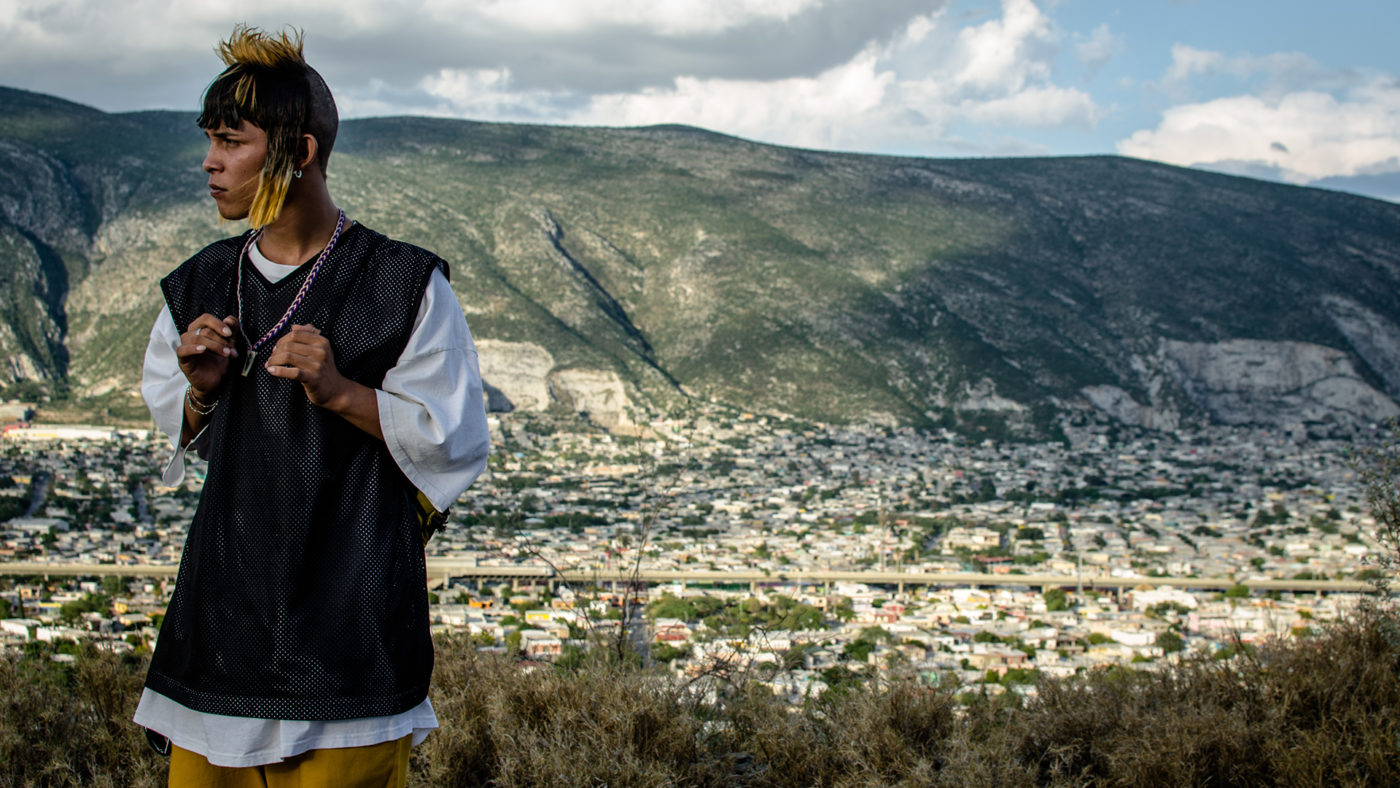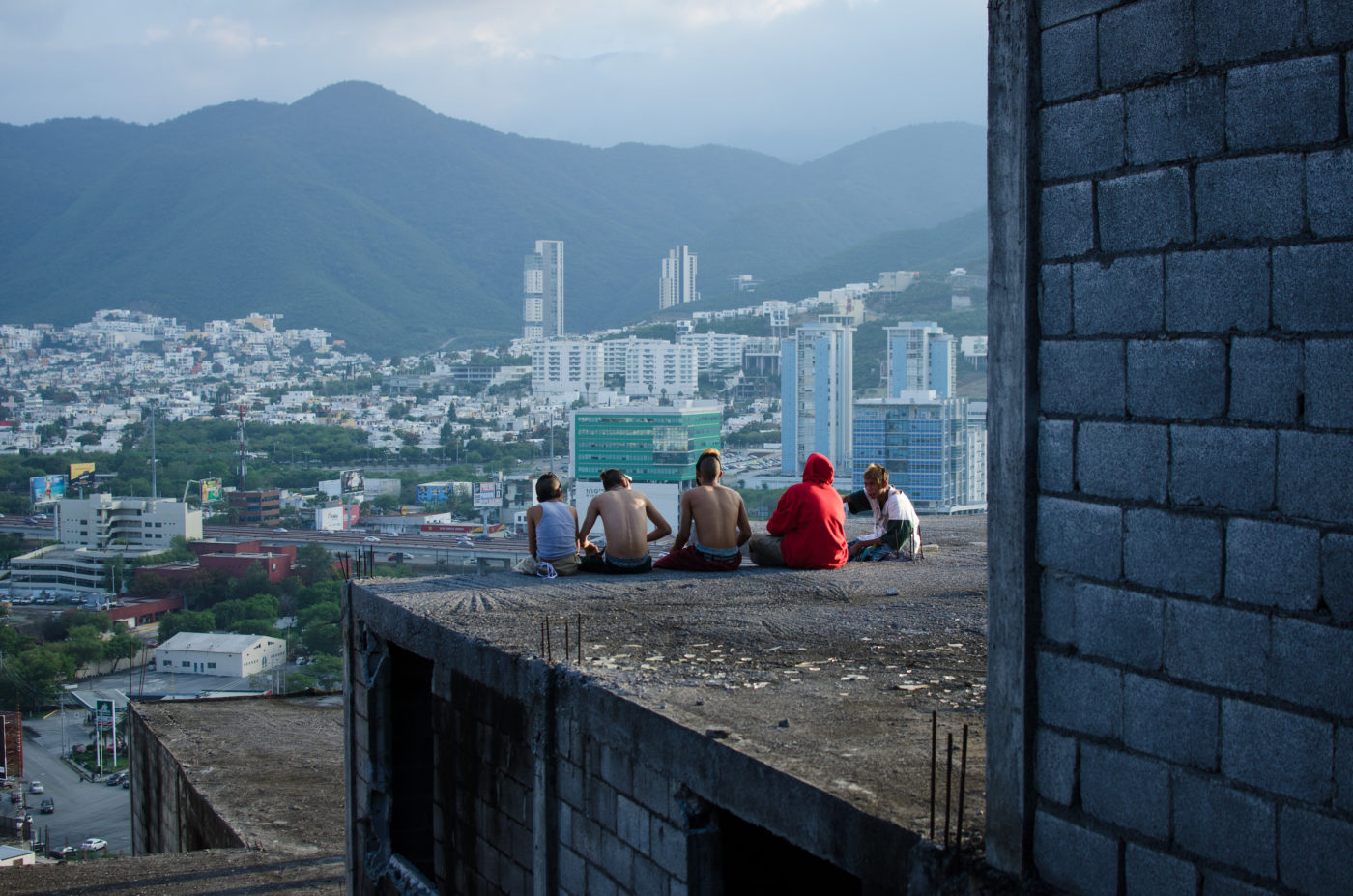A car is parked on a road overlooking a town in the outskirts of Monterrey, Nuevo León, México. From a distance, we see a woman and a young man hug each other; the young man walks towards the backseat of the car as a Volkswagen Beetle approaches from the left side of the frame and stops. A young woman gets out of the Beetle and approaches the young man. His name is Ulisés; his peroxided hair is pulled up in a bun on top with perfectly cut extended sideburns and the back of his head left bald. The girl, Chaparra, gives him a go-away gift: an MP3 player. As Ulisés walks back towards the car, Chaparra drifts off-screen; the woman, who by now we guess is Ulisés’ mom, stands at the right of the frame, almost to the edge, staring resentfully at Chaparra. Later, we see the car driving Ulisés away go up and down a steep rollercoaster like avenue. Cut to Queens, New York where Ulisés follows a middle-aged Mexican into a grocery store owned by a Chinese grandfather to talk about a potential construction and cleaning job.
The opening scene of Fernando Frías de la Parra’s deeply empathetic, poignant, vibrant and ultimately sad new film, I’m No Longer Here (Ya no estoy aquí) may make you think that you are about to experience another miserabilist or triumphalist take on immigration. One where the protagonist faces a series of obstacles to make ends meet in his on her adopted country, while evading la migra, and finding support in a community that fully identifies with his or her plight. Nothing wrong with that storyline; but Frías de la Parra goes to places I haven’t seen before in this type of film. Not only does he explore the forces that uproot a young man from his community but also at the isolation and confusion many immigrants feel in a new, racially diverse world, where even your own countrymen may shun you for being (and even looking) so different from them.
But this is much more than a movie about immigrants. Best known in this country for his work as the director of Season One of HBO’s Los Espookys, the outrageous, droll and altogether brilliant series from Fred Armisen, Ana Fabrega and Julio Torres about a group of horror movie devotees who make a living creating horror scenarios, Frías de la Parra documents and celebrates a subculture that has altogether disappeared: the Kolombia, an underground movement from the barrios of Monterrey built around cumbia rebajada, a slowed down version of the Colombian cumbia. (Monterrey is also the home for such groundbreaking rock mexicano bands as Plastilina Mosh, Control Machete, Kinky and El Gran Silencio, itself a band deeply entrenched in the cumbia tradition). You can feel in every frame the deep respect and empathy Frías de la Parra feels for the young men and women who are part of this culture.

Frías de la Parra cuts back and forth between two time frames: Ulisés (Juan Daniel García Treviño) trying to survive on his own and adapt to the cacophonic, multicultural streets of New York City and the events that led to the seventeen-year-old leaving his hometown. The film takes place at the height of Felipe Calderón’s presidency, around 2010, four years after he declared war on the drug cartels, a war that left over 100,000 dead by the end of his term and that led to the creation of more violent, smaller groups who filled the void left by the many drug lords arrested during this period. Ulisés is the leader of Los Terkos, one of many street gangs in Monterrey that spend their time listening to these slowed down cumbias and participating in nighttime parties that, with their circle dances and swooping bird-like movements, feel almost like rituals. Ulisés is treated by his peers as a local celebrity; girls want to take selfies with him. His late brother was the leader of a local gang known as Los Pelones; its remaining members still look after Ulisés and his friends. Ulisés sets his eyes on an MP3 player containing, according to a local flea market vendor, his entire catalog of cumbia songs. Ulisés’ “fundraising” efforts draw the attention of the cartel trying to muscle in on Los Pelones’ turf and even though he ignores this threat a drive-by shooting forces Ulisés’ family to send him to exile.
Back in Queens, Ulisés is bullied by his fellow day laborers and befriended by Lin (Angelina Chen), the 16-year-old granddaughter of that grocery store owner we met in the first minutes of the film. Her grasp of Spanish is limited and Ulisés never learned English: an English-Spanish dictionary is their only means of communication. He is overwhelmed by the sights, sounds, faces and accents of this new world; the cumbias in his MP3 and his dancing (whenever he is able to dance) are his only solace. The more he yearns for home, the more adrift Ulisés becomes. But unlike the hero of Homer’s classic epic poem, The Odyssey, there is no Penelope waiting for him, with arms opened wide, back home.
Frías de la Parra’s decision to cast nonprofessional actors from the communities he depicts handsomely pays off, especially in the case of Juan Daniel García Treviño who, as Ulisés, delivers a degree of introspection that takes professional actors years to perfect. He is the perfect rebel without a cause; he is defiant, alert but also not immune to those emotions that might be seen by others as a sign of weakness in the rough and tumble streets of Monterrey and Queens. You can tell that a sensitive child hides behind that tough, defiant shield. Frías de la Parra may have written the script but García Treviño and his castmates —from Coral Puente’s Chaparra to Yahir Alday as Sudadera, Los Terkos’ youngest recruit— contribute a high degree of authenticity to the story from how they behave to how they speak (the dialogue in the Monterrey scenes is full of cholo colloquialisms), dress and dance. They make this story theirs.

Frías de la Parra and his director of photography Damián García (Güeros, Museo) eschew the grittiness and shaky hand-held hyperrealism of most social realist dramas for a far more formal approach. The streets of this Monterrey neighborhood may be dusty, full of half-built abandoned buildings, and Monterrey itself may seem like a distant country with its fog-shrouded skyscrapers, but there is also beauty here whether it comes in the form of the mountains that also serve as a backdrop or the alleyways that surround the town’s flea market. Even their choice of angles to highlight their lifestyle — from tight close-ups to show their shoes to a high angle shot to capture Sudadera’s induction into Los Terkos, haircut included— and use of dead space to isolate character goes against the grain. Frías de la Parra and García know when to stand back, when to observe the action as well, as when the new cartel is seen delivering food and other goods to the town folk while berating the government for ignoring them or during a beautiful montage that showcases Los Terkos’ dancing abilities as a group. And in the New York scenes, Manhattan is as inaccessible as Monterrey; Frías de la Parra is far more interested in the hustle and bustle of the boroughs these immigrants call home, street preachers included.
This is the second Latin American film I have seen in the past two months, after Pablo Larraín’s still unreleased Ema, where dance is used by a key character to externalize his or her emotions. It is in these dance scenes where we see the true Ulisés. Dance is not only a means to escape the reality that surrounds him; it is also a means to express his freedom, his individuality. Yes, the cumbias he listens to and which form part of the film’s soundtrack (and story) are as catchy as all hell, but the images of Ulisés dancing, either on his hometown or on a New York subway are the ones that stay with us after the movie is over. I’m No Longer Here is a loving tribute to a dying subculture from a filmmaker in tune with his country’s unique and diverse experiences.
I’m No Longer Here (Ya no estoy aquí) started streaming this week on Netflix.